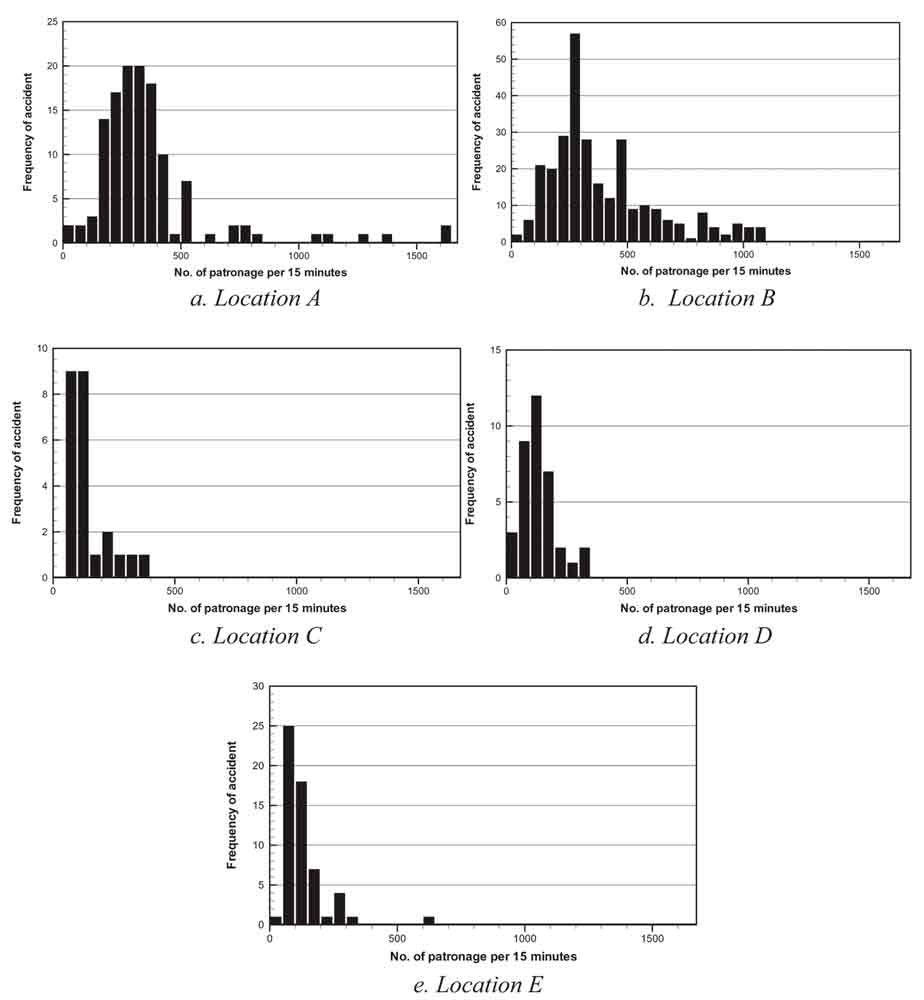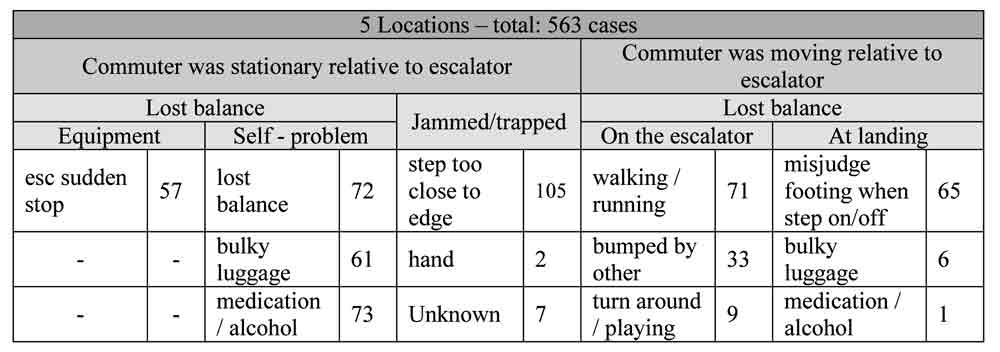Relationship between Escalator Accident Frequency and Commuter Pattern
Mar 1, 2013

by William Wing-hong Lam and Eric Wai-ming, Lee
This paper was presented at  USA 2012, the International Congress on Vertical Transportation Technologies and first published in IAEE book Elevator Technology 19, edited by A. Lustig. It is a reprint with permission from the International Association of Elevator Engineers
USA 2012, the International Congress on Vertical Transportation Technologies and first published in IAEE book Elevator Technology 19, edited by A. Lustig. It is a reprint with permission from the International Association of Elevator Engineers  (website: www.elevcon.com). This paper is an exact reprint and has not been edited by ELEVATOR WORLD.
(website: www.elevcon.com). This paper is an exact reprint and has not been edited by ELEVATOR WORLD.
Key Words: Escalator, accident frequency, crowd density, safety
Abstract
Escalator is popular in public space around the world and, as a facility in built environment, has some characteristics with potential hazards. It has continuously moving parts that exposed to user. It demands users to exercise judgment to synchronize their movement with the escalator when stepping on to and off it. The behaviors of some users have implications to safety of other users.
This paper attempts to explore the correlation between the commuting pattern of crowd movement and escalator safety. In this study, a consistent pattern of a narrow peak of accident frequency occurs at certain utilization rate on escalator. The pattern also indicates that the accident frequency drops significantly when the utilization rate reaches certain level. The findings suggest development of operational measure to improve escalator safety with reference to the utilization rate on escalator. It also suggests the further research direction regarding the modes of accidents associated with the utilization rate; building a model to correlate the factors of the public space and the escalator density and the accident frequency.
1. Introduction
Escalator is an effective way of vertical links between levels in public space in metropolitan cities, in particular, in transit system due to the demand on high capacity. However, escalator is automated mechanical moving equipment which demands users to respond timely, though trivial, in order to ride safely. Around 1,300 persons injured on the 7,300 escalators in the public space Hong Kong every year, i.e., 3 to 4 persons injured every day.
In the scope of the studied public space, the number of accidents and injuries still rise from 1,092 and 1,081 in 2006 to 1,286 and 1,324 in 2009 respectively. The number of accidents and injuries increased by 17.7% and 22.5% respectively from 2006 to 2009 while the number of escalators increased by 7.7 % during the period.
Practitioners of building industry have been working hard to improve escalator safety in various aspects. By examining the various modes of accidents, engineers have improved the details such as skirt guard and lighting on steps to reduce the hazards of shoe jamming and misjudge footing. Regulators and operators have been introducing various measures such as posters and announcement to raise the awareness of users on proper behaviours including holding handrail and standing still.
This paper is a continuation of the paper presented by W Lam in the Hong Kong Institution of Engineers Symposium in Nov 2011 [1]. In the research, the relationship between accident frequency and the utilization rate on escalator is studied. The relationship is built upon the association between the commuter movement and the associated modes of accidents. By analyzing the types of accidents, there are certain accidents that associate with walking on escalators.
The utilization rate, and thus the density of passengers on escalators, affects the degree of freedom of movement on escalators. This research examines the relationship between the accident frequency and the utilization rate of escalators. By identifying the relationship, operators can deploy the operational control according to the patterns of the utilization rate at different time of a day for enhancing the effectiveness of the corresponding safety measures.
2. Relationships Between Accident Frequency And Utilisation Rate Of Escalator
In this research, 10 year accident records of 5 locations of public space are studied. Escalator accidents occurred in the studied public areas in Hong Kong in the period from Year 2000 to Year 2010 were analysed on location basis. Utilization rate is considered to be a good representation of crowding which has certain influence on the human behaviours.
The accident frequency is then plotted against the passenger figure which represents the utilization rate of escalator and thus the density of commuters on escalator at the time of accident.
In all the 5 locations studied, there is a common system behaviour observed from the plots. It depicts in Figure 1 that, in every location, there exists a utilization rate, which is defined as the number of passengers entering into the location for every 15 minutes, where the accident frequency is the highest. Beyond the optimal density, the accident frequency drops significantly. It is interesting that there is a second peak at higher density for all the 5 locations.
For Locations C, D and E, the peak occurs at utilization rate of around 100 passengers per 15-minute; and the second peak occurs at utilization rate of around 200-300 passengers per 15-minute. For Locations A and B, the peak occurs at utilization rate around 200-300 passengers per 15-minute; and the second peak occurs at around 450-500 passengers per 15-minute.
3. Discussion On Characteristics Of The Plots
It has been generally expected that more accidents would occur when there are more commuters riding on escalator. In contrast to the general expectation, the peak occurs at a much lower utilization rate. The pattern indicates that accidents on escalators are more likely
to occur at certain density of passengers on escalator. The density can associate with various
factors, including:
- degree of freedom to walk or run on escalator,
- degree of freedom to fall,
- degree of freedom to carry out any activities that require space such as reading newspaper,
- alert level,
- types of commuters.
Another important pattern is that the frequency of accidents drops significant at density beyond the second peak, for Locations C, D and E, at around 300 commuters per 15-minutes. For Locations A and B, the frequency of accidents drops significantly at density beyond 550 commuters per 15-minutes.
In developing hypothesis for further studies, it is considered that accident frequency may associate with the degree of freedom of physical movements and the interaction with the alert level. Starting with very few commuters on escalator, the alert level is low and the probability of clash between commuters due to walking is also low. When the number of commuters grows, the probability of clash between commuters rises but the alert level may not rises accordingly while the commuter density is still quite low. When the commuter density further rises, the probability of clash further rises and at the same time commuters are more cautious to avoid clashing, and as a result, the accident frequency starts to drop. When the commuter density continues to rise, it reaches to a state that commuters cannot walk on escalator and certain modes of accident cannot occur.
This possibly explains why there are significant difference between the accident and the utilisation rate in different locations as the commuters in different districts have different standards of crowding and thus different patterns of alert level in response to the crowding level. The accident frequencies of districts of similar types are similar and there may possibly be several types of patterns according to the nature of the districts, i.e., residential, commercial, retail, industrial, and various combinations of those.
4. Factors Attributing To Escalator Accidents
In exploring the causes of the characteristics, the context of use of escalator in public space is examined. Typically, the context comprises the factors as outlined in Figure 2.
In examining the factors that the utilisation rate of escalator, or the patronage, represents, there are actually a number of above factors associated. The immediate factor associated with patronage is the density on the escalator. The patronage also relates to the time, i.e., higher patronage usually occurs in peak hour of working day. The peak / non-peak hours can reflect the purpose of commuting and hence the mental state of the commuter in terms of whether in hurry, or alert level. The type of district, whether it is residential or commercial, affects the pattern of commuters in terms of the behaviours and thus the risks associated with the behaviours.
Hence these factors shown in Figure 2 have various degree of influence to occurrence of an accident with certain interactions with each others. On the other hand, many of these factors cannot be measured or identified in normal situation before an accident occurs; some factors cannot be captured even after occurrence of an accident, as well as are not controllable.
As the first layer of information in understanding the dynamic of these factors attributing to an escalator accident, the patronage is considered to be a collection of factors. It is a factor that can be captured and monitored in real time by operator. Operational measures can be deployed according to the patronage level that considered being at higher risk according to the result of this research.
5. Analysis Of Causes Of Accidents At The 5 Locations
From the data of the 5 locations in the period of Year 2000 to Year 2010, the causes of accidents are summarised in Table 1.
Table 1 Summary of causes of accidents in the 5 locations from year 2000 to 2010
There are total 71 cases (12.6%) of commuters walking or running on escalator while the accident occurred; and 33 cases (5.8%) of commuters bumped by other moving commuters. If putting the causes associated with spatial degree of freedom including the walking, bumped by other walking commuters, and turn around, there are total 113 cases (20.0%) that can potentially addressed through monitoring of the patronage level.
6. Data – Limitations And Assumptions
The key focus of this study is the analysis of the accident records of the past 10 years in identified public areas in Hong Kong. There are, however, limitations in analysing past record as listed below:
The classification of types of accidents was governed by the way the accidents were reported and recorded at the time the recording system was established;
The judgement of the cause of accidents was done by different personnel and the difference in judgement would cause some degree of inconsistency inevitably;
The mechanism of counting commuters provides only the total number in every 15 minutes;
Various changes have been applied to the installation as well as the use of escalators in the past 3 decades and the changes may or may not have implication to the safety performance.
Out of the various factors or parameters, the utilization rate of escalator, and thus the density of passengers on escalator at the time accident occurred was studied. Escalator accidents occurred in the studied public areas in Hong Kong in the period from Year 2000 to Year 2010 were analysed on location basis. Utilization rate is considered to be a good representation of crowding which has certain influence on the human behaviours.
7. Signifigance Of The Result To Operation
The patterns are important for operators to deploy the manpower for regulating crowd movement. Understanding the pattern of accident frequency can help operators to set up more effective operational control. The data of the utilization rate and thus the density of commuters on escalators can be transmitted in real time to the operators for monitoring of commuters level and deciding the deployment of manpower to regulate the crowd movement.
8. Further Study
Identifying the characteristics of the plots is the beginning of understanding of the relationship between commuter behaviours and the utilization rate of escalators that associated with accidents. This study demonstrates that there is a maximal point in the relationship between escalator accident frequency and the patronage. There are a series of follow-up questions leading to further research to explore:
- Is the maximal point predictable?
- Can the maximal point be altered by changing the parameters of the building configuration?
- Can the escalator accident frequency be reduced by changing the parameters of the building configuration?
- Is there an optimal safety performance for a building configuration?
- Are there rules for the parameters of building configuration in order to achieve an optimal safety performance?
A consistent pattern is identified in this study on the 5 locations. The next step is to conduct similar plots to more locations to test the repetitiveness of the pattern; and to assess the predictability of the pattern. Predictability of the safety performance is a key step of the research in order to explore whether changing the parameters of building configuration can alter the safety performance.
REFERENCE
Lam W.H.W. (2011) Relationship between Escalator Accident Frequency and Commuter Pattern, Hong Kong Institution of Engineers Symposium.
Get more of Elevator World. Sign up for our free e-newsletter.











